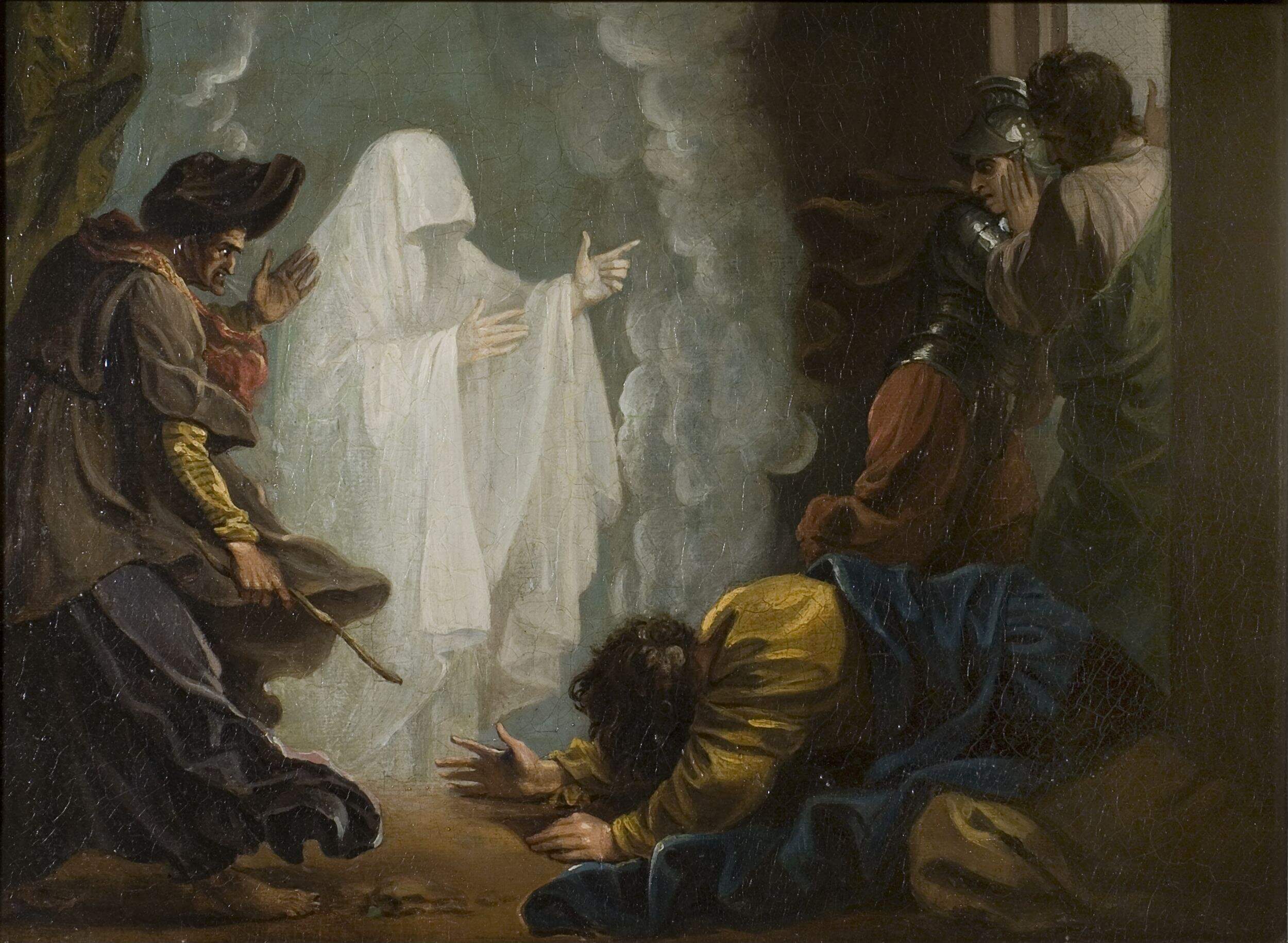
Not a Friend of ASOR yet? Sign up here to receive ANE Today in your inbox weekly!

March 2023
Vol. 11, No. 3
Are Possession and Other Spirit Phenomena Depicted in the Hebrew Bible?
By Reed Carlson
Pop culture tropes have often had an outsized influence on how laypersons and scholars alike conceive of possession and other similar spirit phenomena. For example, motifs familiar from gothic horror fiction, depictions of exorcism in popular cinema, and historical accounts of the tribulations of premodern witch trials have shaped an eclectic set of expectations concerning what typically constitutes spirit experiences and their associated religious practices. This set of expectations includes the assumption that spirit phenomena are largely private and marginal practices in society and that they are punctuated by brief and intense encounters with powerful supernatural forces. Almost uniformly, such experiences are portrayed as involuntary, undesirable, and overwhelming—that is, that spirit possession implies the complete abdication of a person’s personality over to an invading entity.

These portraits were not painted solely from storytellers’ imaginations. Socio-political forces have helped to shape these stereotypes, especially in Western cultures. The stories gathered in the Western tradition about spirit phenomena in non-European societies, for example, have often been told in ways that are intentionally grotesque and exploitatively exotic. These depictions have frequently served colonial interests by portraying some cultures as rational and inherently dominant and others as irrational and thus in need of mastery. Accordingly, political, capitalist, and religious powers have sometimes promoted the characterization of spirit-influenced individuals and communities as liabilities to social order, economic growth, and the common good.
Given this array of negative associations, it is not surprising that many interpreters of the Hebrew Bible rule out the presence of spirit phenomena in the literature of ancient Israel and early Judaism. But this dismissal is erroneous. The Hebrew Bible does depict spirit possession and other similar phenomena, but not in the mold of prevalent modern paradigms. In particular, spirit phenomena in the Hebrew Bible are most commonly portrayed as corporate (that is, including groups of people), cultivated (that is, intentional practices that one can be skilled or unskilled in), and constant (that is, not necessarily episodic so much as quotidian aspects of daily life). These observations are consistent with the findings of cultural anthropologists and ethnographers who study contemporary, non-Western forms of spirit possession around the world today.
The most obvious places to start a search for spirit phenomena in the Hebrew Bible are texts where the word rûaḥ (plural: rûḥôt) appears. Most frequently rûaḥ is rendered into English as “wind,” “breath,” or “spirit.” While early research on this term in biblical literature sought to map which of these senses was intended in each individual occurrence, more recent scholarship has better recognized how notions of winds, spirits, and illnesses were intimately connected in the ancient Near East. Thus, it best to understand any given instance of rûaḥ in the Hebrew Bible as intersecting all these meanings at once, even if one sense may be foregrounded more than another in each text.
Acknowledging this wide semantic range for rûaḥ is essential for recognizing spirit phenomena in the Hebrew Bible, because the ideas of wind, breath, and spirit all contribute to evolving cultural models for the behavior of rûḥôt in human bodies. In one model, which commentators have referred to variously as the animating or abiding mode, spirits are envisioned as the sustaining power for all living creatures:
When you hide your face, they are dismayed;
When you take away their breath (rûaḥ), they die
and return to their dust.When you send forth your spirit (rûaḥ), they are created,
and you renew the face of the ground. (Ps 104:29–30 NRSV)
These spirits can be depicted as arriving at birth and departing at death (see Gen 2:7; 1 Kgs 17:17; Qoh 11:5). This coincides well with the idea of rûaḥ as breath. Spirit phenomena in this mode are often linked with wisdom, skill, and the agency to carry out righteous action (see Gen 41:38–39; Exod 28:3; Deut 34:9; Mic 3:8). This mode appears often with the metaphors of filling or pouring.
A second model, which commentators have referred to as the charismatic or migrating rûaḥ, is envisioned as a temporary empowerment for a specific purpose. This mode is often associated with leadership, military prowess, and prophecy (see Num 24:2–3a; Jdg 3:10; 1 Sam 19:20). Many examples use locative constructions (for example, “the spirit of the LORD was upon”), but rûaḥ can also appear as the subject of a dynamic verb (see “clothe” Jdg 6:34; “stir” Jdg 13:25; “seize” 1 Sam 10:6; “lift up” Ezek 3:14). Some of these examples may work especially well with the idea of rûaḥ as wind, though this conceptual distinction should not be overstated. The abiding vs migrating types are not systematic theologies but rather unconscious cultural models, which can exist side-by-side, perhaps in tension or in collaboration. Thus, for example, Ezekiel’s descriptions of God’s spirit “entering” him seem to combine a broad semantic range of rûaḥ:
And when he spoke to me, a spirit (rûaḥ) entered into me and set me on my feet, and I heard him speaking to me (Ezek 2:2 NRSV)
This semantic range can also be observed in the psalmist’s petition that God create a “new and right spirit” within, which will, in contrast to the previous spirit, grant the psalmist the ability to avoid sin (Ps 51).
Do these examples of spirit language qualify as spirit phenomena in the sense I have described above? Once again, interpreters should consider what preconceptions they may have about what constitutes an authentic spirit experience. Centuries of theological thought in both Jewish and Christian tradition have treated much of the spirit language of the Bible as metaphorical or abstract. Based on comparison with ethnographic reports of spirit practices today, however, it seems that more often such language reflects actual spirit practices and/or the literary presentation of religious experiences. These may be visionary encounters (see Ezek 37:1–14), spirit-inspired dramas or prophetic performances (see 1 Kgs 22:6–28), or the enactment of a spirit curse (see 2 Kgs 19:7//Isa 37:7). In antiquity and today, spirit influence most frequently manifests, at least initially, as a type of ailment, a pneumatological anthropology that is reflected throughout the book of Job (see Job 4:15; 6:4 7:7).
Finally, some of the best examples of spirit experiences depicted in the Hebrew Bible are connected to the figure of King Saul. Saul is presented as an especially spiritually porous person, whose initial spirit experiences are empowering (see 1 Sam 10:5b–6; vv. 9–10). As Saul loses favor with the deity, however, his spirit experiences change. After God’s spirit moves to another (1 Sam 16:13), Saul is tormented by a harmful spirit, which distresses him and causes aggressive behavior (1 Sam 16:14–15; 18:10; 19:9; compare 20:33).
Now the spirit of the Lord departed from Saul, and an evil spirit from the Lord tormented him. And Saul’s servants said to him, “See now an evil spirit from God is tormenting you. Let our lord now command the servants who attend you to look for someone who is skillful in playing the lyre, and when the evil spirit from God is upon you, he will play it, and you will feel better.” (1 Sam 16:14–16 NRSV)
Just as music cultivated his positive spirit experiences (1 Sam 10:5; compare 2 Kgs 3:15) so does he seek it out for treating his negative ones (1 Sam 16:16–17, 23). Saul’s spirit experiences, sometimes explained away as “madness,” reveal instead the complex ways that the realms of mental illness and spirit experience overlap. Saul’s spirit encounters reach their culmination in his attempted consultation with the departed prophet Samuel by means of a professional medium at En-Dor (1 Sam 28). The medium (she is never called a “witch”) successfully possesses the departed presence of Samuel against his will (1 Sam 28:15). Contrary to popular depictions of this episode, Samuel is not present as a visual apparition. Rather, the dead prophet speaks through the body of the medium, as per her profession.
In short, possession and other spirit experiences are common phenomena in human religious practice, and we should not be surprised to see evidence of their cultivation in antiquity. The inability of interpreters to recognize such phenomena in the Hebrew Bible says more about the expectations of modern biblical scholars than it does about the literature itself.
Reed Carlson is Assistant Professor of Biblical Studies at United Lutheran Seminary in Pennsylvania and the author of Unfamiliar Selves in the Hebrew Bible: Possession and Other Spirit Phenomena, published by De Gruyter.
Want To Learn More?
Death Wishes in the Hebrew Bible
By Hanne Løland Levinson
A number of figures in the Bible express the wish to die. These statements reflect despair but most often represent efforts to bargain with a higher power. Read More
Who’s Afraid of the Goddess of Ancient Israel?
By Dvora Lederman Daniely
Many scholars believe that Asherah was the consort of the Israelite god Yahweh. The Biblical texts speak disapprovingly of Asherah worship in the temple itself, but was the goddess encoded elsewhere in the texts? Read More


